Understanding World Societies:
Printed Page 138
INDIVIDUALS IN SOCIETY
Archimedes, Scientist and Inventor

Archimedes was born in the Greek city of Syracuse in Sicily, an intellectual center in which he pursued scientific interests. He was the most original thinker of his time and a practical inventor. In his book On Plane Equilibriums, he dealt for the first time with the basic principles of mathematics, including the principle of the lever. He once said that if he were given a lever and a suitable place to stand, he could move the world. He also demonstrated how easily his compound pulley could move huge weights with little effort:
A three-
He likewise invented the Archimedian screw, a pump to bring subterranean water up to irrigate fields, which quickly came into common use. In his treatise On Floating Bodies, Archimedes founded the science of hydrostatics. He concluded that an object will float if it weighs less than the water it displaces, and that whenever a solid floats in a liquid, the weight of the solid equals the weight of the liquid displaced. This discovery and his reaction to it has become famous:
When he was devoting his attention to this problem, he happened to go to a public bath. When he climbed down into the bathtub there, he noticed that water in the tub equal to the bulk of his body flowed out. Thus, when he observed this method of solving the problem, he did not wait. Instead, moved with joy, he sprang out of the tub, and rushing home naked he kept indicating in a loud voice that he had indeed discovered what he was seeking. For while running he was shouting repeatedly in Greek, “Eureka, eureka” (“I have found it, I have found it”).†
War between Rome and Syracuse unfortunately interrupted Archimedes’s scientific life. In 213 B.C.E., during the Second Punic War, the Romans besieged the city. Hiero, its king and Archimedes’s friend, asked the scientist for help in repulsing Roman attacks. Archimedes began to build remarkable devices that served as artillery. One weapon shot missiles to break up infantry attacks. Others threw huge masses of stones that fell on the enemy with incredible speed and noise. They tore gaping holes in the Roman lines and broke up attacks. For use against Roman warships he is said to have designed a machine with beams from which large claws dropped onto the hulls of enemy warships, hoisted them into the air, and dropped them back into the sea. Later Greek authors reported that he destroyed Roman ships with a series of polished mirrors that focused sunlight and caused the ships to catch fire. Modern experiments recreating Archimedes’s weapons have found that the claw may have been workable, but the mirrors probably were not, as they required a ship to remain stationary for the fire to ignite. It is not certain whether his war machines were actually effective, but later people recounted tales that the Romans became so fearful that whenever they saw a bit of rope or a stick of timber projecting over one of the walls protecting Syracuse, they shouted, “There it is. Archimedes is trying some engine on us” and fled. After many months the Roman siege was successful, however, and Archimedes was killed by a Roman soldier.
QUESTIONS FOR ANALYSIS
- How did Archimedes combine theoretical mathematics and practical issues in his work?
- What applications do you see in the world around you of the devices Archimedes improved or invented, such as the lever, the pulley, and artillery?

DOCUMENT PROJECT
What advances in technological warfare occurred during the Hellenistic period? Read accounts of the siege of Syracuse, and then complete a quiz and writing assignment based on the evidence and details from this chapter. See Document Project for Chapter 5